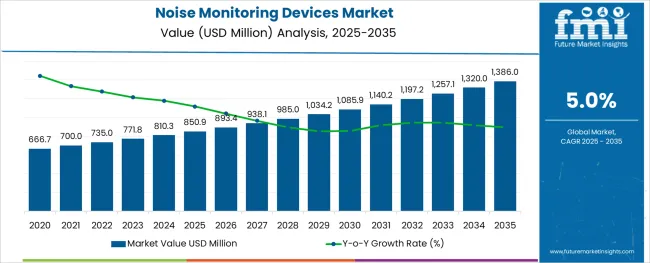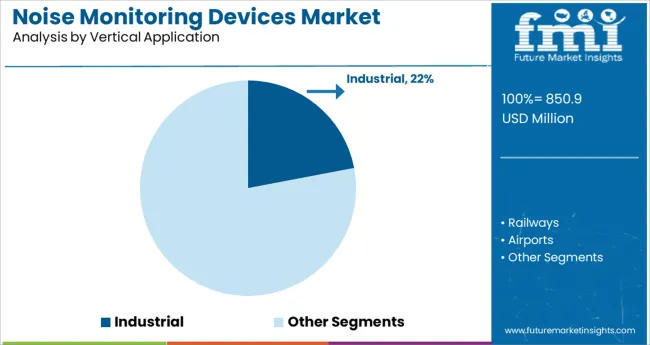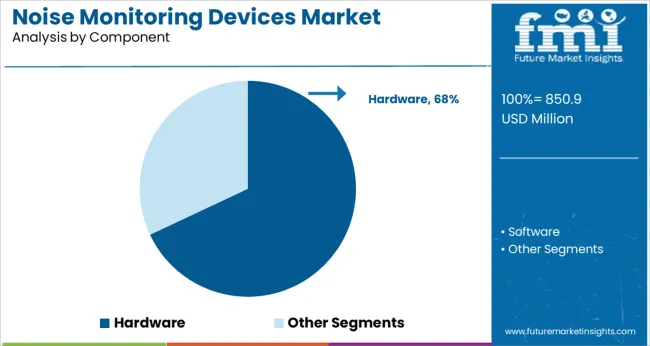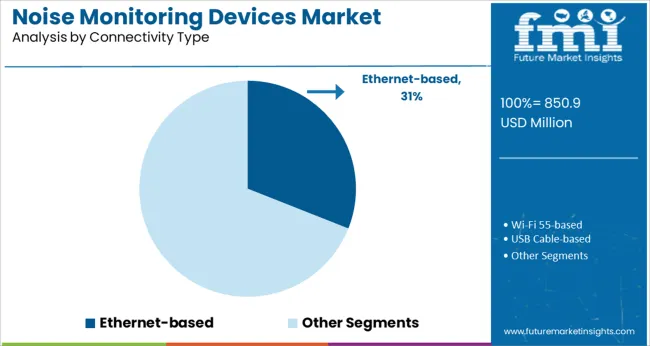The Noise Monitoring Devices Market is estimated to be valued at USD 850.9 million in 2025 and is projected to reach USD 1,386.0 million by 2035, registering a compound annual growth rate (CAGR) of 5.0% over the forecast period.

The noise monitoring devices market is experiencing steady expansion, underpinned by rising global awareness of noise pollution, stricter occupational safety mandates, and environmental impact assessments. Industries and municipalities are adopting these devices to ensure compliance with noise level thresholds, mitigate legal liabilities, and maintain community well-being. Technological advancements in acoustic sensors, cloud-based analytics, and remote diagnostics are enabling more efficient monitoring and actionable insights.
Additionally, integration of smart connectivity, automation in measurement protocols, and data-driven reporting tools has enhanced the utility of noise monitoring systems across construction zones, factories, transportation corridors, and entertainment venues.
Government-backed initiatives to track ambient sound levels in smart cities and industrial areas are further propelling demand. Future growth is expected from the convergence of IoT, AI-driven acoustic profiling, and cloud-based environmental monitoring platforms that facilitate predictive analysis and decentralized noise management.
The market is segmented by Vertical Application, Component, Connectivity Type, and Type of Noise and region. By Vertical Application, the market is divided into Industrial, Railways, Airports, Recreational Areas, Hospitals, Residential Areas, Construction Sites, Road Traffic, Commercial Applications, and Other Applications. In terms of Component, the market is classified into Hardware and Software.
Based on Connectivity Type, the market is segmented into Ethernet-based, Wi-Fi 55-based, USB Cable-based, and Cellular-based. By Type of Noise, the market is divided into Class 1 Standard 51 and Class 2 Standard 52. Regionally, the market is classified into North America, Latin America, Western Europe, Eastern Europe, Balkan & Baltic Countries, Russia & Belarus, Central Asia, East Asia, South Asia & Pacific, and the Middle East & Africa.

The industrial segment is projected to account for 22.0% of the total revenue share in the noise monitoring devices market in 2025. This growth is being driven by increased compliance obligations under occupational health and safety standards, which require real-time monitoring of sound exposure levels in high-decibel work environments.
Industries such as manufacturing, mining, construction, and energy have adopted fixed and portable noise monitoring systems to safeguard worker health, ensure audit readiness, and avoid regulatory penalties.
These systems support long-duration data logging, automated alerts, and seamless integration with factory safety systems, enabling proactive noise control. Rising investments in worker safety infrastructure and growing corporate ESG commitments are also fueling the adoption of acoustic surveillance solutions across industrial facilities.

Hardware components are expected to dominate the market with a 68.0% revenue share in 2025. This leadership is being driven by the critical role of sensors, microphones, data loggers, and environmental enclosures in capturing and transmitting accurate noise data.
Precision-engineered hardware forms the backbone of reliable noise monitoring systems, especially in outdoor, industrial, and high-traffic environments where rugged design and calibration consistency are essential. Continuous innovations in sensor miniaturization, battery efficiency, and IP-rated enclosures have expanded the range of deployable monitoring points.
The widespread preference for standalone and networked noise measurement devices has reinforced hardware’s position as the primary value driver, even as cloud and analytics software adoption grows. With increased deployment in both permanent installations and mobile monitoring tasks, hardware investments remain the core focus for public and private sector buyers.

Ethernet-based connectivity is projected to capture 31.0% of the market revenue share in 2025, reflecting its reliability and data integrity advantages in fixed monitoring installations. This connectivity type is favored in industrial plants, urban infrastructure, and commercial settings where secure, high-bandwidth transmission of continuous acoustic data is required.
Ethernet networks enable seamless integration with centralized monitoring dashboards, SCADA systems, and cloud servers, ensuring uninterrupted real-time access to noise profiles. Unlike wireless systems, Ethernet provides low-latency performance and enhanced cyber-security, which are critical for regulatory compliance and automated reporting.
The use of power-over-Ethernet (PoE) technologies has also simplified installation by reducing cabling complexity and improving energy efficiency. As more facilities prioritize deterministic data flows for environmental monitoring, Ethernet-based connectivity is expected to remain essential in high-reliability applications.
The global demand for noise monitoring devices is projected to increase at a CAGR of 3.7% during the forecast period between 2025 and 2035, reaching a total of USD 1,386 Million in 2035, according to a report from Future Market Insights (FMI). From 2020 to 2024, sales witnessed significant growth, registering a CAGR of 1.6%.
The high prevalence of occupational hearing loss is propelling the growth of the noise monitoring devices Market. Hearing loss is ranked as the world's fourth most severe handicap. This element contributes to a growing global awareness of the growing need for accessible hearing care.
According to the estimates, there are presently over 466 million individuals worldwide who suffer from hearing loss. Rising worker safety concerns in industries such as oil and gas, mining, chemical, healthcare, transportation, and other industrial sectors are driving noise monitoring devices trends. The rising occurrence of industrial injuries is one of the world's significant issues today.
Upgrading Of All the Major Enterprises to Accelerate the Market Growth
The global market for noise monitoring devices is expanding rapidly. The noise monitoring devices market offers several advantages for measuring and managing noise levels. The upgrading of all the major enterprises is what drives the market. Furthermore, in the industry, there are continual momentum games that influence the market with innovative technology.
The global market for noise monitoring devices is rapidly expanding. The videos of Portuguese data existing in the noise monitoring devices market have the greatest CAGR, which is predicted to expand further in South Asia in the next years. The use of ethernet and cellular communication removal data storage devices weather sensors interface AC battery or solar power, and other technologies are growing. All of this implies an increase in demand for the noise monitoring devices market.
A Lack of Enforcement of Effective Legislation Implementation in Emerging Nations to Restrain the Market Growth
The primary factors inhibiting the growth of the noise monitoring device market are workplace carelessness and a lack of enforcement of effective legislation implementation in emerging nations.
Increasing Workplace Hearing Impairment Incidences to Fuel the Market Growth

The noise monitoring devices market in North America is expected to accumulate the highest market share of 28.9% in 2025. North America will dominate the noise monitoring device market from 2025 to 2035.
Increasing workplace hearing impairment incidences in industrial areas, imposition of stringent government rules and norms related to noise pollution, demand for reducing noise pollution in private property areas, and need for customized noise monitoring devices & software for retail users are the major factors driving the market's growth in the North American region.
Rising Noise Pollution in the Region to Fuel Market Growth
The noise monitoring devices market in Asia-Pacific is expected to accumulate a significant market share of 13% in 2025 and is expected to continue to maintain the trend over the forecast period as well.
During the forecast period, the Asia Pacific region is predicted to be the fastest-expanding sector in the noise monitoring devices market. Rising noise pollution and increased government pressure to regulate noise pollution are the primary drivers driving the APAC region's growth.
Presence of Major Key Players in the Region to Widen Prospects

The noise monitoring devices market in Europe is expected to accumulate a market share value of 21.7% in 2025. Over the projected period, Europe's noise monitoring device market is predicted to dominate the industry.
The presence of key industry players characterizes the expansion of the sector. The European government is quite strict on noise policies. To avoid significant penalties, businesses in this region must maintain and monitor noise levels on a regular basis.
The Industries Vertical Application Segment to Drive the Noise Monitoring Devices Market
The noise monitoring devices market is segmented by vertical application in railways applications, airports applications, recreational areas applications, industries applications, hospitals applications, residential areas applications, construction sites applications, road traffic applications, commercial applications, and other applications.
From 2025 to 2035, the noise monitoring devices market for industrial applications is predicted to develop at the fastest rate. The cause for this rapid expansion is the rising adoption of noise monitoring regulations by businesses all over the world.
The government's increasing emphasis on public health and safety has compelled enterprises to control factory noise and offer adequate noise-reducing equipment to personnel working in high-noise zones. This has also broadened the market for noise monitoring devices.
With growing noise pollution and government restriction, it has become really important to keep tabs on the noise levels around us. Hence, demand for noise monitoring devices is increasing and to meet the demand the market has ample new start-ups, some of which are mentioned below:

Prominent players in the noise monitoring devices market are Honeywell International Inc., Casella Inc., FLIR Systems, RION Co. Ltd., CESVA INSTRUMENTS SLU, ACOEM Group, Pulsar Instruments, SKF Group, PCE Instruments, Brüel & Kjaer, Cirrus Research Plc, NTi Audio, Larson Davis, Svantek, and KIMO are among others.
| Details | Report Attribute |
|---|---|
| Growth Rate | CAGR of 5% from 2025 to 2035 |
| Market Value in 2025 | USD 850.9 million |
| Market Value in 2035 | USD 1,386.0 million |
| Base Year for Estimation | 2024 |
| Historical Data | 2020 to 2024 |
| Forecast Period | 2025 to 2035 |
| Quantitative Units | Revenue in million and CAGR from 2025 to 2035 |
| Report Coverage | Revenue Forecast, Company Ranking, Competitive Landscape, Growth Factors, Trends, and Pricing Analysis |
| Segments Covered | Vertical Application, Component, Connectivity, Type of Noise, Region |
| Regions Covered | North America; Latin America; Europe; Asia Pacific; Middle East and Africa |
| Key Countries Profiled | The USA, Canada, Brazil, Mexico, Germany, The United Kingdom, France, Spain, Italy, China, Japan, South Korea, Malaysia, Singapore, Australia, GCC Countries, South Africa, Israel |
| Key Companies Profiled | 3M Communications; SINUS Messtechnik GmbH; Honeywell International Inc.; Casella Inc.; Forward Looking InfraRed (FLIR) Systems; RION Co. Ltd.; CESVA INSTRUMENTS SLU; ACOEM Group; Pulsar Instruments; SKF Group (Svenska Kullagerfabriken); PCE Instruments; Brüel & Kjaer; Cirrus Research Plc.; NTi Audio (New Technologies in Audio); Larson Davis; Savntek; Kommunernes International Miljoorganisation (KIMO) |
The global noise monitoring devices market is estimated to be valued at USD 850.9 million in 2025.
It is projected to reach USD 1,386.0 million by 2035.
The market is expected to grow at a 5.0% CAGR between 2025 and 2035.
The key product types are industrial, railways, airports, recreational areas, hospitals, residential areas, construction sites, road traffic, commercial applications and other applications.
hardware segment is expected to dominate with a 68.0% industry share in 2025.






Full Research Suite comprises of:
Market outlook & trends analysis
Interviews & case studies
Strategic recommendations
Vendor profiles & capabilities analysis
5-year forecasts
8 regions and 60+ country-level data splits
Market segment data splits
12 months of continuous data updates
DELIVERED AS:
PDF EXCEL ONLINE
Noise And Vibration Coatings Market Size and Share Forecast Outlook 2025 to 2035
Noise Insulation Jackets Market Size and Share Forecast Outlook 2025 to 2035
Noise Control System Market Analysis - Size, Share, and Demand Forecast Outlook 2025 to 2035
Noise-muffling Infant Hat Market
Noise Vibration Harshness (NVH) Testing Market
Noise Control Enclosures Packaging Market
Pass By Noise Testing Market Size and Share Forecast Outlook 2025 to 2035
Outdoor Noise Barrier Market
Industrial Noise Control Market Size and Share Forecast Outlook 2025 to 2035
Monitoring Tool Market Size and Share Forecast Outlook 2025 to 2035
Pet Monitoring Camera Market Size and Share Forecast Outlook 2025 to 2035
Pain Monitoring Devices Market Size and Share Forecast Outlook 2025 to 2035
Dose Monitoring Devices Market - Growth & Demand 2025 to 2035
Brain Monitoring Market Size and Share Forecast Outlook 2025 to 2035
Motor Monitoring Market Size and Share Forecast Outlook 2025 to 2035
Neuro-monitoring System Market Size and Share Forecast Outlook 2025 to 2035
Media Monitoring Tools Market Size and Share Forecast Outlook 2025 to 2035
Power Monitoring Market Report - Growth, Demand & Forecast 2025 to 2035
Urine Monitoring Systems Market Analysis - Size, Trends & Forecast 2025 to 2035
Brain Monitoring Systems Market is segmented by Lateral Flow Readers and Kits and Reagents from 2025 to 2035

Thank you!
You will receive an email from our Business Development Manager. Please be sure to check your SPAM/JUNK folder too.
Chat With
MaRIA